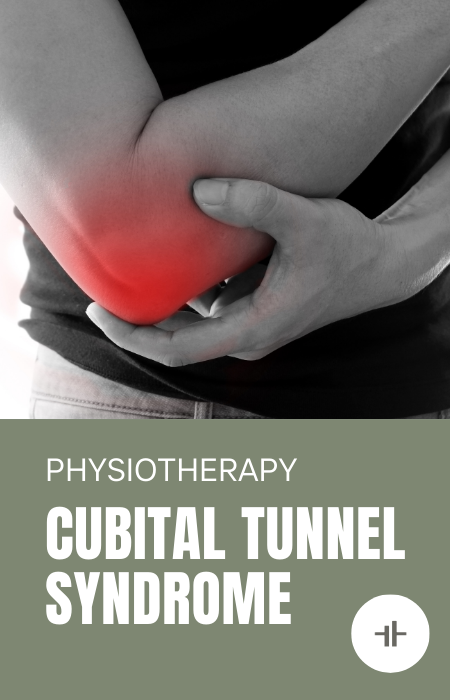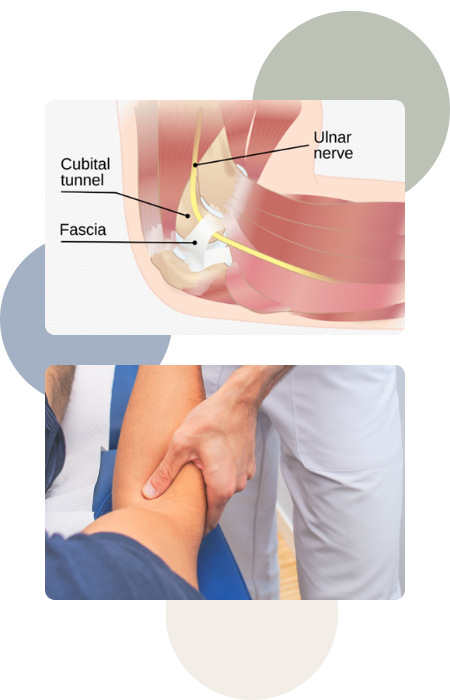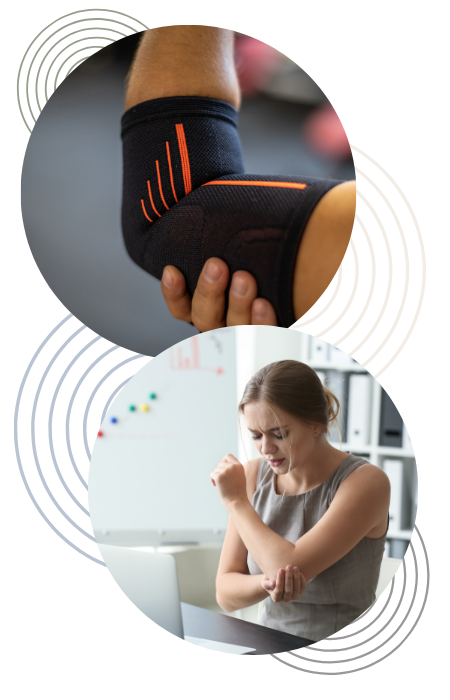Let's Get You Moving Again — Reclaim Your Mobility
- Direct Billing with ICBC and Major Insurance ProvidersExpert guided Personalized Treatment Plans
Physiotherapy for Cubital Tunnel Syndrome
Nerve compression in your elbow causing tingling fingers and weakening grip strength? Our specialized physiotherapy for cubital tunnel syndrome uses proven manual therapy and nerve mobilization techniques that target the source of ulnar nerve irritation, helping patients regain function through evidence-based conservative treatment.

Cubital Tunnel Syndrome
What is Cubital Tunnel Syndrome?
Cubital tunnel syndrome is a form of ulnar nerve entrapment that occurs when the ulnar nerve becomes compressed or irritated as it passes through the narrow cubital tunnel at the medial epicondyle of your elbow. This nerve compression affects sensation in your ring and little fingers while controlling key hand muscles for gripping and fine motor control.
The cubital tunnel is a tight anatomical space formed by bone, ligaments, and soft tissue where the ulnar nerve travels behind the medial epicondyle. When pressure increases within this tunnel through elbow flexion, direct trauma, or repetitive movements, it creates nerve entrapment that leads to progressive symptoms.
Common triggers include prolonged elbow positioning, sustained pressure on the cubital tunnel, and activities that many professionals encounter daily during computer work or phone use.
Key characteristics include:
- Intermittent numbness and tingling in the ulnar nerve distribution
- Progressive weakness in hand grip strength and precision tasks
- Symptoms that worsen with sustained elbow flexion or pressure on the tunnel
Unlike surgery, physiotherapy addresses nerve mobility and reduces pressure within the cubital tunnel through non-invasive techniques, making it the preferred treatment approach for this form of nerve compression.
Cubital Tunnel Syndrome
When Should You Consider Physiotherapy for Cubital Tunnel Syndrome Treatment
Physiotherapy becomes essential when you experience persistent ulnar nerve symptoms affecting daily activities, work performance, or sleep. Research shows that physiotherapy can have beneficial effects in reducing subjective and objective symptoms and improving function in cubital tunnel syndrome patients.
You should seek immediate assessment if you notice:
- Numbness or tingling in the ulnar nerve distribution that persists beyond occasional episodes
- Difficulty performing fine motor tasks due to hand weakness or elbow pain
- Grip weakness that affects carrying objects or manipulating tools
- Symptoms that worsen during typical activities or with sustained elbow flexion
- Sleep disruption due to nighttime numbness, tingling, or pressure on the cubital tunnel
Early physiotherapy intervention prevents progression to irreversible nerve damage and muscle wasting. Patients often develop this syndrome from increased remote work postures and repetitive elbow positioning, making timely treatment crucial for preventing permanent damage.
The ideal treatment window occurs when ulnar nerve symptoms are present but before significant muscle weakness develops in the hand and forearm, typically within the first 3 to 6 months.


Cubital Tunnel Syndrome
How Does Physiotherapy for Cubital Tunnel Syndrome Work?
Physiotherapy targets the underlying mechanisms causing ulnar nerve compression through evidence-based manual techniques and specific exercises. The treatment approach focuses on improving nerve mobility within the tunnel, reducing pressure around the cubital tunnel, and correcting biomechanical factors contributing to nerve entrapment.
Our treatment protocol begins with comprehensive assessment including nerve conduction evaluation to identify specific compression sites and contributing factors. Manual therapy techniques include gentle ulnar nerve mobilization to restore normal nerve gliding within the cubital tunnel, reducing adhesions that restrict movement around the medial epicondyle.
When patients experience significant muscle tension contributing to nerve compression, we may incorporate advanced techniques such as IMS Therapy to release trigger points in the forearm muscles. For cases involving chronic inflammation or scar tissue around the tunnel, Shockwave Therapy can help stimulate healing. Additionally, Cupping may be used to improve circulation and reduce tissue tension in the affected area.
Neurodynamic exercises form the cornerstone of recovery, teaching the ulnar nerve to move freely through its pathway while maintaining optimal elbow positioning. These exercises, performed regularly, gradually restore normal nerve function and prevent recurrence of tunnel syndrome.
The treatment process addresses both local pressure within the cubital tunnel and systemic factors affecting the ulnar nerve pathway from the forearm to the hand. Patients learn specific techniques to avoid positions that increase pressure on the tunnel while strengthening surrounding muscles.
Why Choose BLVD for Cubital Tunnel Syndrome Treatment
Evidence-Based Approach: Our physiotherapists utilize current research-supported neurodynamic assessment and treatment approaches for ulnar nerve entrapment, including comprehensive movement analysis to identify contributing factors affecting the cubital tunnel and personalized treatment protocols for each syndrome presentation.
Advanced Techniques: We employ specialized manual therapy techniques combined with targeted ulnar nerve mobilization exercises, following current best practices for conservative cubital tunnel syndrome management. Our approach addresses both local pressure within the tunnel and systemic factors affecting nerve function.
BLVD's approach combines evidence-based manual therapy with personalized exercise prescription tailored to your specific ulnar nerve symptoms and lifestyle demands. Our Burnaby clinic features modern tools such as Shockwave Therapy and treatment techniques designed to optimize recovery outcomes for patients with nerve compression conditions.
Understanding that each case of tunnel syndrome requires individualized care, we focus on addressing the unique factors contributing to your elbow and hand symptoms, whether related to workplace ergonomics, sleep positioning, or activity-related trauma.
Book a Cubital Tunnel Syndrome Assessment today and experience our comprehensive approach to ulnar nerve compression recovery.
FAQs
How long does physiotherapy take to work for cubital tunnel syndrome?
Can physiotherapy cure cubital tunnel syndrome without surgery?
Will my symptoms get worse before they improve?
Is physiotherapy covered by insurance for cubital tunnel syndrome?
How can I prevent cubital tunnel syndrome from returning?
Direct Billing with Major Extended Health Benefits Plans



.svg.avif)








Tuesday
Wednesday
Thursday
Friday
Saturday
Sunday
7:00 am to 7:00 pm
7:00 am to 7:00 pm
7:00 am to 7:00 pm
7:00 am to 7:00 pm
7:00 am to 7:00 pm
Closed
Other services
Communities We Serve

